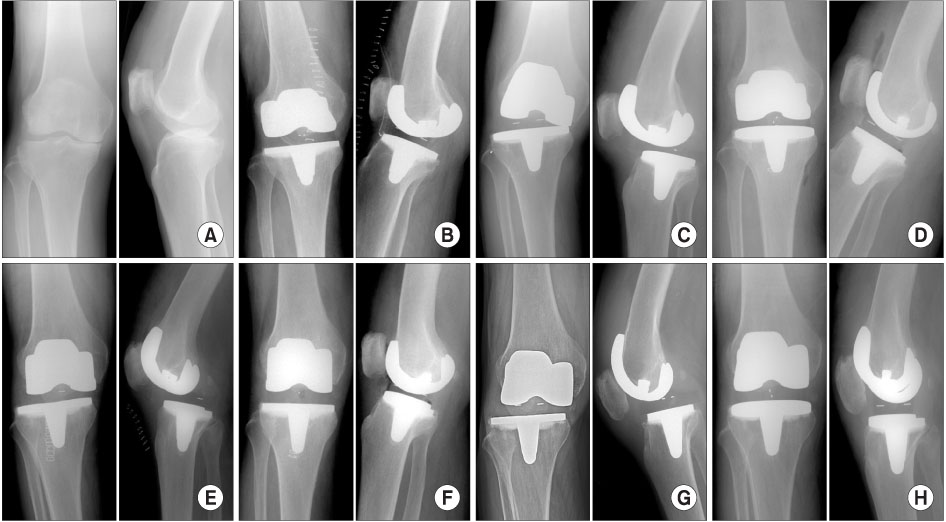J Korean Orthop Assoc.
2007 Apr;42(2):221-226. 10.4055/jkoa.2007.42.2.221.
Total Knee Arthroplasty with Rotating Platform Low Contact Stress(R): Minimum 3-Year Follow-up Results
- Affiliations
-
- 1Department of Orthopedic Surgery, Yonsei University College of Medicine, Seoul, Korea. ihyang@yumc.yonsei.ac.kr
- KMID: 854591
- DOI: http://doi.org/10.4055/jkoa.2007.42.2.221
Abstract
- PURPOSE: To retrospectively evaluate the clinical and radiology results of total knee arthroplasty using a rotating platform Low Contact Stress (LCS(R)) Complete(TM). MATERIALS AND METHODS: Of 63 patients (82 knees) who had undergone a total knee arthroplasty with a rotating platform LCS(R) Complete(TM) between Jan. 2001 and Dec. 2002, 61 patients (79 knees) were followed up for more than three years and evaluated retrospectively. The average follow-up period was 3.5 years and the diagnosis in all cases was degenerative osteoarthritis. The average age at the time of surgery was 67.4 years, and no patient underwent patella resurfacing. RESULTS: The average active range of motion increased from 118degrees (95degrees-134degrees) preoperatively to 123degrees (100degrees-140degrees) at the last follow up. The average flexion contracture improved from 15degrees (0degrees-30degrees) preoperatively to 2degrees (0degrees-10degrees) at the last follow up. The average HSS knee score also improved from preoperative 64 points to 90 points at the last follow up. The radiology evaluation revealed a radiolucency rate of 10% in the tibia anteroposterior view and 9% in the femur. The complications encountered were two cases of a polyethylene liner dislocation; one in whom an open reduction was performed, and the other in whom the liner had been exchanged. CONCLUSION: A follow-up of the rotating platform LCS(R) Complete(TM) of more than three years yielded overall satisfactory results in the range of motion and function. However, there should be some concern regarding the development of polyethylene liner dislocation.
Figure
Reference
-
1. Bert JM. Dislocation/subluxation of meniscal bearing elements after New Jersey low-contact stress total knee arthroplasty. Clin Orthop Relat Res. 1990. 254:211–215.
Article2. Buechel FF, Pappas MJ. Long-term survivorship analysis of cruciate-sparing versus cruciate sacrificing knee prosthesis using meniscal bearings. Clin Orthop Relat Res. 1990. 260:162–169.3. Buechel FF, Pappas MJ. New Jersey low contact stress knee replacement system. Ten-year evaluation of meniscal bearings. Orthop Clin North Am. 1989. 20:147–177.4. Callaghan JJ, O'Rourke MR, Iossi MF, et al. Cemented rotating-platform total knee replacement. A concise follow-up, at a minimum of fifteen years, of a previous report. J Bone Joint Surg Am. 2005. 87:1995–1998.5. Dennis DA, Komistek RD, Stiehl JB, Walker SA, Dennis KN. Range of motion after total knee arthroplasty: the effect of implant design and weight-bearing conditions. J Arthroplasty. 1998. 13:748–752.
Article6. Ewald FC. The Knee Society total knee arthroplasty roentgenographic evaluation and scoring system. Clin Orthop Relat Res. 1989. 248:9–12.
Article7. Ewald FC, Jacobs MA, Miegel RE, Walker PS, Poss R, Sledge CB. Kinematic total knee replacement. J Bone Joint Surg Am. 1984. 66:1032–1040.
Article8. Goldberg VM, Figgie HE 3rd, Figgie MP. Technical considerations in total knee surgery. Management of patella problems. Orthop Clin North Am. 1989. 20:189–199.9. Heck DA, Kettlekamp DB. General considerations in total knee arthroplasty. Instr Course Lect. 1986. 35:265–271.10. Kaper BP, Smith PN, Bourne RB, Rorabeck CH, Robertson D. Medium-term results of a mobile bearing total knee replacement. Clin Orthop Relat Res. 1999. 367:201–209.11. Keblish P. Results and complications of the LCS (low contact stress) knee system. Acta Orthop Belg. 1991. 57:Suppl 2. 124–127.12. Outerbridge RE. The etiology of chondromalacia patellae. J Bone Joint Surg Br. 1961. 43:752–757.
Article13. Ranawat CS, Boachie-Adjei O. Survivorship analysis and results of total condylar knee arthroplasty. Eight- to eleven-year follow-up period. Clin Orthop Relat Res. 1998. 226:6–13.14. Ritter MA, Gioe TJ, Stringer EA, Littrell D. The posterior cruciate condylar total knee prosthesis. A five-year follow-up study. Clin Orthop Relat Res. 1984. 184:264–269.15. Scott RD, Volatile TB. Twelve years' experience with posterior cruciate-retaining total knee arthroplasty. Clin Orthop Relat Res. 1986. 205:100–107.
Article
- Full Text Links
- Actions
-
Cited
- CITED
-
- Close
- Share
- Similar articles
-
- Condylar Lift Off in Fixed and Mobile Bearing Total Knee Arthroplasty
- The Short-term Results of PFC Sigma Rotating-Platform in Total Knee Arthroplasty
- A Comparison of the Clinical and Radiographic Results of Press Fit Condylar Rotating-Platform High-Flexion and Low Contact Stress Mobile Bearing Prosthesis in Total Knee Arthroplasty: Short term Results
- Comparison of the Clinical Outcomes after Total Knee Arthroplasty with the LCS Rotating Platform Mobile Bearing Knee System and the PFC Sigma RP-F Mobile Bearing Knee System
- Moderate to Severe Varus Deformity in Total Knee Arthroplasty: PFC Sigma Fixed Bearing Versus Rotating Platform


